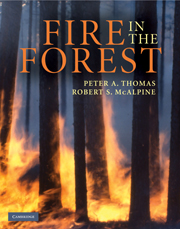Book contents
- Frontmatter
- Contents
- Preface
- List of contributors
- 1 In the beginning
- 2 Historical review
- 3 How a fire burns
- 4 Fire in the wild landscape
- 5 Fire ecology
- 6 The benefits of fire and its use as a landscape tool
- 7 Fire suppression
- 8 Wildland fire and its management – a look towards the future
- Further reading
- References used in the text
- Index
4 - Fire in the wild landscape
Published online by Cambridge University Press: 05 August 2012
- Frontmatter
- Contents
- Preface
- List of contributors
- 1 In the beginning
- 2 Historical review
- 3 How a fire burns
- 4 Fire in the wild landscape
- 5 Fire ecology
- 6 The benefits of fire and its use as a landscape tool
- 7 Fire suppression
- 8 Wildland fire and its management – a look towards the future
- Further reading
- References used in the text
- Index
Summary
The previous chapter explains how a fire burns and what types of fire are possible. But once out in the real world there are many influences that determine whether a fire starts and how it subsequently behaves. First of all, there has to be a source of ignition – the spark or heat source intense enough to cause combustion – and this has to coincide with some sort of flammable material in a dry enough state to burn. Once the fire has started, its behaviour in terms of how fast and far it will spread and how much energy it produces is primarily controlled by the weather, the shape of the terrain (topography) and the amount and state of the fuel. These three factors can be fitted together as a fire behaviour triangle (see Fig. 4.5); change one side of the triangle and the fire regime will also change, often dramatically. Which one of these factors is most important in shaping the fire of an area will vary depending on the region, the ecosystem type and historical events such as previous fires.
The fire regime of an area can be defined as the characteristic frequency, extent, intensity and seasonality of fires within an area. You should also be aware that the fire itself can influence the weather and fuel sides of the triangle and hence the fire regime – it is a two-way process.
- Type
- Chapter
- Information
- Fire in the Forest , pp. 54 - 89Publisher: Cambridge University PressPrint publication year: 2010
- 1
- Cited by



